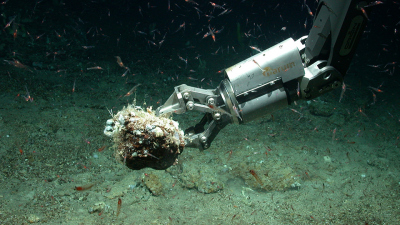Life on the Ocean Floor

It is cold and dark in the deep sea. Until just a few decades ago people believed it to be a largely barren habitat. This perception has now drastically changed. Our present knowledge of the deep sea, with its unique and often fragile ecosystems, is a direct result of new and progressive technological instruments. These allow remotely controlled investigations to be carried out even at the greatest water depths and under extreme conditions. Nevertheless, the largest areas by far of the deep sea and ocean floor remain virtually unknown to us.
The role that the deep sea, and particularly the ocean floor, plays in the Earth System is the central focus of research at MARUM – Center for Marine Environmental Sciences at the University of Bremen. This institute is the home of the Cluster of Excellence “The Ocean Floor – Earth’s Uncharted Interface”.
Interactive dive to the deep sea
Visitors to the interactive exhibition “3,688 Meters Below Sea Level” will have the opportunity to look over the shoulders of marine researchers. Step-by-step, in the House of Science, they will learn more about the ocean floor as a large and continuous ecosystem, about how scientists prepare for expeditions to the deep sea, and the technological tools they use.
“As archives of the environmental and climatic changes in the past, the deposits on the ocean floor are extremely important, and not only for climate research. The ocean floor is also one of the primary interfaces for global material cycles such as the carbon cycle,” says Prof. Dr. Michael Schulz, Director of MARUM and head of the Cluster of Excellence.
- More information on the exhibition and lecture program (in German):
- More information on the House of Science:
- More information on the Cluster of Excellence “Ocean Floor” at the University of Bremen:
Contact for more information:
Dr. Frank Schmieder
Transfer and Science Communication
MARUM – Center for Marine Environmental Sciences, University of Bremen
Telephone: 0421-218 65542
Email: [Bitte aktivieren Sie Javascript]
Original exhibits from the deep
An interactive comic illustrates how science is carried out on a research ship, and follows a submersible vehicle to hydrothermal seeps in the deep sea. On a large digital world map the visitors can progressively drain the water out of the world ocean as a way to explore the ocean floor themselves. The exhibition also displays actual specimens from the depths of the sea, including the skeletons of cold-water corals and a fragment of a black smoker. In addition, there are 3-D models of large tools that are employed in modern marine research, and of tiny microorganisms that are helpful in scientific climate research.
“When the submersible vehicles dive, there is a palpable excitement on board. What new underwater worlds are the team going to see? We want to share this fascination for research with the visitors,” says Dr. Frank Schmieder, who conceived the exhibition together with Nils Strackbein from MARUM’s Transfer and Science Communication team.
Speaker program and photo exhibit
During the exhibition, the lecture series “Knowledge at 11” will focus on the research work of MARUM scientists. On July 22, Prof. Wolfgang Bach will speak on the hydrothermal seeps on the seafloor. The lecture by Dr. Maren Walter on August 26 will focus on hydrothermal seeps in the Arctic Ocean. On September 23, Prof. Achim Kopf will speak on the topic of CO2 sequestration in the ocean crust. Dr. Ursula Röhl will wrap up the series on October 21 with her lecture on climate archives from the ocean floor.
In addition, the photo exhibition “Expedition Deep Sea”, which can be seen in the House of Science until August 23, presents the technical equipment that is deployed in the deep sea by scientists in the Cluster of Excellence. Visitors here can dive to the fascinating ecosystems of the deep sea. Admission to both exhibitions is free.
The exhibition is modular and will be expanded further in the future. It will thus be possible to display it in different dimensions and spaces.
MARUM produces fundamental scientific knowledge about the role of the ocean and the seafloor in the total Earth system. The dynamics of the oceans and the seabed significantly impact the entire Earth system through the interaction of geological, physical, biological and chemical processes. These influence both the climate and the global carbon cycle, resulting in the creation of unique biological systems. MARUM is committed to fundamental and unbiased research in the interests of society, the marine environment, and in accordance with the sustainability goals of the United Nations. It publishes its quality-assured scientific data to make it publicly available. MARUM informs the public about new discoveries in the marine environment and provides practical knowledge through its dialogue with society. MARUM cooperation with companies and industrial partners is carried out in accordance with its goal of protecting the marine environment.


